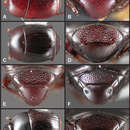Description
provided by Zookeys
Length (nontype only measured): 2.12 mm, width: 1.68 mm; body rufescent, elongate, subdepressed, approximately parallel-sided; frons weakly depressed, frontal stria divergent at sides, almost evenly arcuate across front, weakly sinuate above antennal bases; supraorbital stria absent; epistoma flat; labrum about twice as wide as midline length, apex asymmetrical, shorter on right side than left; left mandible slightly produced at base, right with acute basal tooth; pronotum lacking prescutellar impression, disk with fine, inconspicuous ground punctation, with numerous (>20) coarser punctures along sides; marginal pronotal stria broadly interrupted behind head; submarginal pronotal stria continuous along lateral and anterior margins, but weakly angulate behind eyes; median pronotal gland openings simple, slightly less than one-half pronotal length behind anterior pronotal margin; elytron with two complete epipleural striae, outer subhumeral stria interrupted at middle, inner subhumeral stria present only in apical half, striae 1-3 complete, 4th stria present in just over apical half, 5th stria present in apical half, sutural stria present in apical two-thirds; elytral disk with irregular series of apical marginal punctures; pronotal keel projecting at base, carinal striae complete, sinuate, meeting in narrow anterior arch; anterior mesoventral margin distinctly emarginate, marginal stria complete or interrupted at middle; mesometaventral stria displaced anterad, transverse across middle of mesoventrite, bend posterolaterad, continued by lateral metaventral stria toward middle of metacoxa; 1st abdominal ventrite with inner lateral stria complete, outer abbreviated, without postmetacoxal fovea; propygidium with ground punctation fine, sparse, densely covered with small coarse punctures, separated by much less than their diameters; pygidium with dense, fine ground punctation, with numerous coarser punctures interspersed, more densely toward apex; marginal pygidial sulcus complete, moderately deep, weakly crenulate. Male genitalia (Figs 68A–E): accessory sclerites present, very small, not basal; T8 broad and short, sides curving to subtruncate apex; apical emargination narrow, moderately deep, basal emargination broadly arcuate, basal membrane attachment line distad basal emargination by about one-fourth its depth, ventrolateral apodemes most strongly developed basally, narrowed to apex; S8 more or less parallel-sided, apical guides narrow at base, broadening to rounded apices, with distinctly membraneous inner edges, halves narrowly fused at extreme ventral base, divergent to apex; T9 with sides rounded, convergent to subacute, weakly convergent apices; T10 cordate, fused along midline in basal half; S9 [of only available male broken] with stem narrowed near apex, with narrow apical emargination, apical flanges separate; tegmen short and broad, widest about one-third from apex, with extremely large and projecting medioventral tooth, in addition to distinct ventrolateral cusp on body of tegmen; median lobe with wide gonopore, long proximal apodemes, showing weak differentiation; basal piece about one-third tegmen length.
- license
- cc-by-3.0
- copyright
- Michael S. Caterino, Alexey K. Tishechkin
- bibliographic citation
- Caterino M, Tishechkin A (2013) A systematic revision of Operclipygus Marseul (Coleoptera, Histeridae, Exosternini) ZooKeys 271: 1–401
- author
- Michael S. Caterino
- author
- Alexey K. Tishechkin

